G.Skill TridentX Review: 2x4GB at DDR3-2666 C11-13-13 1.65V
by Ian Cutress on October 28, 2012 12:00 PM ESTNext in our line of memory reviews is a kit I have actually had at my work desk for a while. In the land of overclockers, synthetics are everything – if it can get a higher number on a screen, and that number can be pushed, then it is worth it. Thus in steps comes G.Skill with their high end TridentX range, pushing the boat from DDR3-2400 (both 4GB and 8GB modules) all the way up to DDR3-2800 (4GB modules only). The kit we are testing today falls right in the middle of all of this, being a 2x4 GB kit of DDR3-2666 11-13-13. This is an 8 GB kit that retails at $170, and for that money we could easily pick up a 2x8 GB 2400 C10 kit. Proof will be in the pudding as we put this kit through the testing suite – let us see if it is actually relevant for day-to-day use.
G.Skill 2x4GB DDR3-2666 C11 Kit Overview
Back in our initial memory overview, I gave a couple of formula in order to calculate (at a high level) how a memory kit should act in sequential and random reads. The formulas were:
Time to read one word: CL * 2000/MHz
Time to read eight words: CL * 2000/MHz + (7*1000/MHz)
Applying this to the G.Skill kit we have in today gives us 8.25ns for a one word read, and 10.88ns for reading eight words. For comparison, the following memory speeds offer similar scores:
DDR3-2000 C8: 8.00ns/11.50ns
DDR3-2133 C9: 8.44ns/11.72ns
DDR3-2133 C10: 9.38ns/12.66ns
DDR3-2400 C10: 8.33ns/11.25ns
DDR3-2400 C11: 9.17ns/12.08ns
DDR3-2600 C10: 7.69ns/10.38ns
DDR3-2600 C11: 8.46ns/11.15ns
DDR3-2666 C10: 7.50ns/10.13ns
DDR3-2666 C11: 8.25ns/10.88ns
DDR3-2800 C11: 7.86ns/10.36ns
DDR3-2800 C12: 8.57ns/11.07ns
Most of these kits should be available for sale around the same price, but purely by these numbers the 2666 C11 has an advantage over both the 2400 C10 and the 2800 C12. Moving up to 2666 C10 obviously has the advantages of the lower command rate.
With the G.Skill 2666 C11 kit we are testing today, as it is the highest rated kit we have tested, it clearly gets top marks across almost all of our benchmarks. Obviously there are some benchmarks that enjoy the MHz (Batman:AA, WinRAR), but others either tend towards a limit (Portal 2 on IGP) due to other factors becoming limiting, or some would prefer more memory as a whole (Thunderbolt copying, more on that later), or others need a nicer balance between MHz and Command Rate (catia in SPECviewperf).
The kit is also great at overclocking. Like I said, I have had this kit for a while, and part of playing around with the kit was an attempt to push the MHz as far as it would go. In that respect the kit easily pushed 2800 C11 at stock volts, and 2950 C12 with a bit more juice. Given that plenty of kits on the market will not move an inch above XMP at stock volts, this is nice to see.
The downsides to this kit are predominantly two-fold. The cost per GB is astronomical, especially compared to the other kits we have tested. In our memory overview, the 1866 C9 4x4GB kit performed at almost the same level as this 2666 C11 2x4GB kit for double the capacity and $75 less. That is a shocking statement – the only way to show that the 2666 C11 kit is a mountain and a half better than the 1866 C9 kit is through synthetics, which rarely have a real-world influence, especially in memory.
As a result, this kit is purely for the extreme overclockers out there – those that need and can feel the difference between 2666 C11 and 2400 C11 by virtue of the number they get on a screen. It will be some time before a kit of this high specifications comes down to a reasonable price (sub $100) for the rest of the userbase to be interested.
Specifications
| G.Skill | GeIL | G.Skill | |||||
| Kit Speed | 1333 | 1600 | 1866 | 2133 | 2400 | 2400 | 2666 |
| Subtimings | 9-9-9-24 | 9-9-9-24 | 9-10-9-28 | 9-11-10-28 | 11-12-12-30 | 10-12-12-31 | 11-13-13-35 |
| Price | $75 | $80 | $95 | $130 | $150 | $145 | $170 |
| XMP | No | Yes | Yes | Yes | Yes | Yes | Yes |
| Size | 4 x 4 GB | 4 x 4 GB | 4 x 4 GB | 4 x 4 GB | 2 x 8GB | 4 x 4 GB | 2x4GB |
|
|
|||||||
| MHz | 1333 | 1600 | 1867 | 2134 | 2401 | 2401 | 2667 |
| Voltage | 1.500 | 1.500 | 1.500 | 1.650 | 1.650 | 1.650 | 1.650 |
| tCL | 9 | 9 | 9 | 9 | 11 | 10 | 11 |
| tRCD | 9 | 9 | 10 | 11 | 12 | 12 | 13 |
| tRP | 9 | 9 | 9 | 10 | 12 | 12 | 13 |
| tRAS | 24 | 24 | 28 | 28 | 30 | 31 | 35 |
| tRC | 33 | 33 | 37 | 38 | 47 | 43 | 48 |
| tWR | 10 | 12 | 14 | 16 | 14 | 16 | 16 |
| tRRD | 4 | 5 | 5 | 6 | 6 | 7/6 | 7 |
| tRFC | 107 | 128 | 150 | 171 | 362 | 313 | 214/213 |
| tWTR | 5 | 6 | 8/7 | 9/8 | 8 | 10/9 | 10 |
| tRTP | 5 | 6 | 8/7 | 9/8 | 8 | 10/9 | 10 |
| tFAW | 20 | 24 | 24 | 25 | 27 | 26 | 27 |
| tCWL | - | 7 | 7 | 7 | 11 | 7 | 7 |
| CR | - | 2 | 2 | 2 | 2 | 2 | 2 |
The big change over previous kits is the tRFC, the Row Refresh Cycle time. tRFC is defined as the minimum wait in cycles required following a refresh to an idle bank before it can be again activated for access. This should mean that reads from subsequent rows requiring a refresh will be faster compared to the 2400 C10/C11 kits we have tested.
Visual Inspection
This TridentX kit is essentially the same as the previous TridentX 2400 C10 kit we reviewed - TridentX is one notch above RipjawsZ, and spans kits from DDR3-2400 C9 to DDR3-2800 C11. The main features on the kit (aside from the speeds) are the heatsinks, to which G.Skill have added a detachable fin. Without the fin, the module is approximately 9mm above the module, and with the fin the total height is 22mm above the PCB. That is a lot of height for a memory module that in 99% of circumstances would not produce enough temperature to trouble any build.
In order to remove the fin there is a screw at each end of the module, and the fin slides off effortlessly. The fins fit very well, but upon attempting to reattach a fin I was unable to get it on as securely as it came out of the box, leaving a little wobble in the fin. There is no cause for alarm if you get a module with a wobbly fin – nothing is wrong, and it will not affect the heat dissipation as much as most users may think. Most modules output a few watts at best, so dissipation of several watts of energy without a fin is simple enough.
One thing I should point out with the TridentX modules is the fins are actually very sharp – if you are trying to put these modules into a motherboard where the range of movement to apply pressure is small, wear some gloves. I actually did take some skin off my hand doing exactly this, trying to use my fingers and palm to push the modules down.
As with the previous TridentX 2400C10 kit, putting such a large module in our TRUE Copper scenario was a recipe for disaster:
Even putting the module in the second slot faired no better:
All the testing for this review was done on an ASUS P8Z77-V Premium motherboard with the Intel stock cooler, so module movement is not much an issue in that case, but big air coolers still get a lot of usage (and is more often than not an investment over several updates), so there are things to consider when purchasing memory.


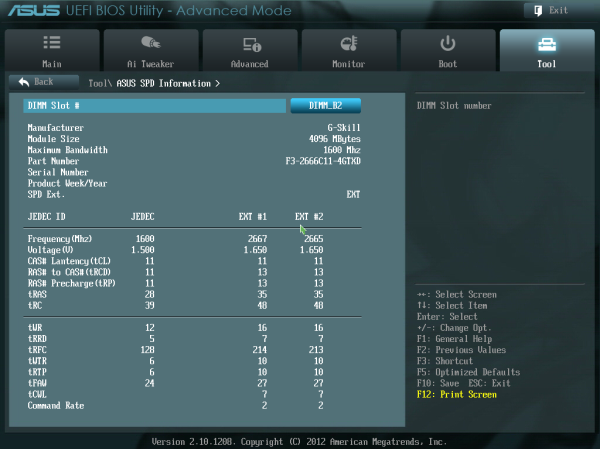
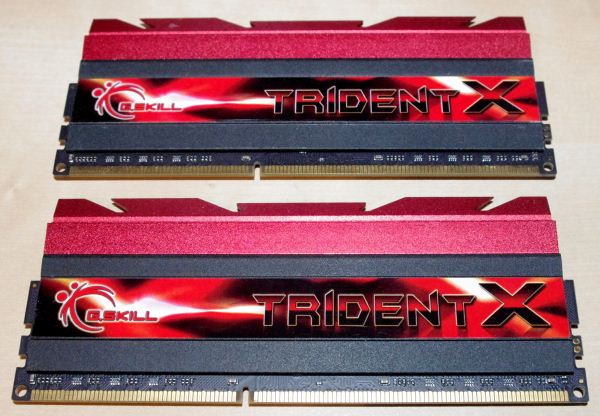
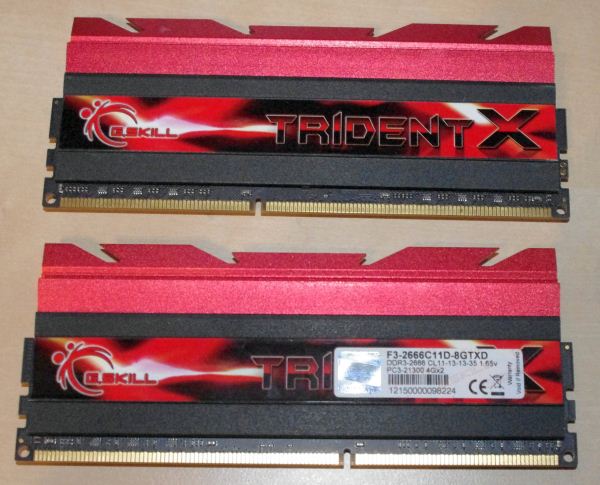
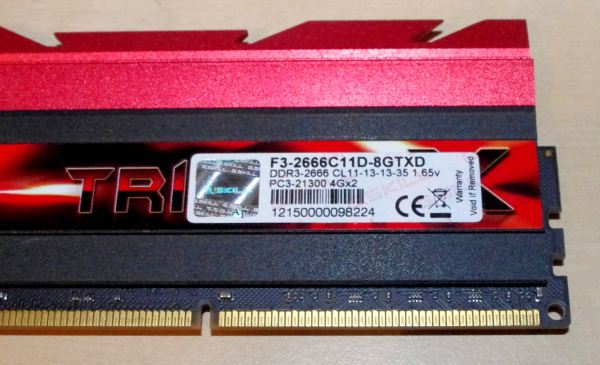

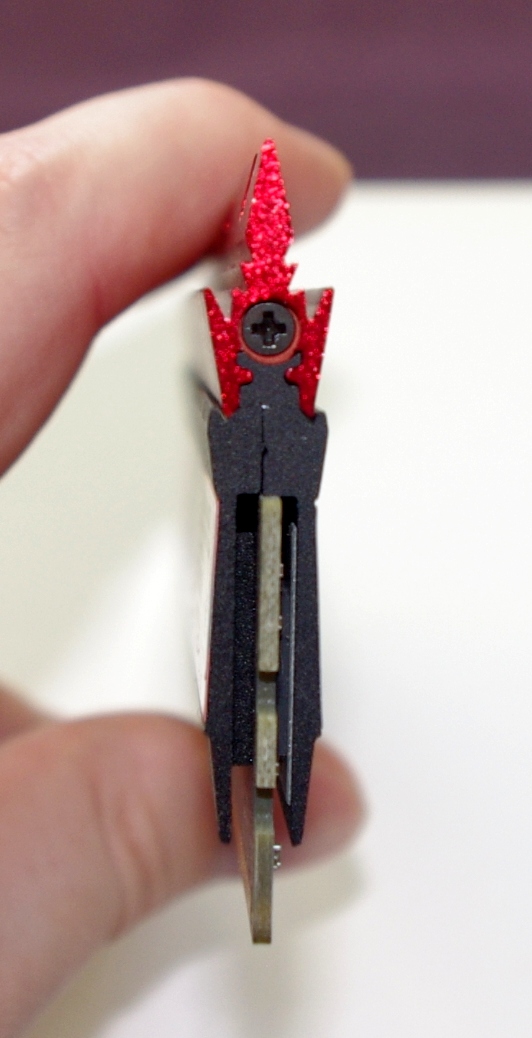
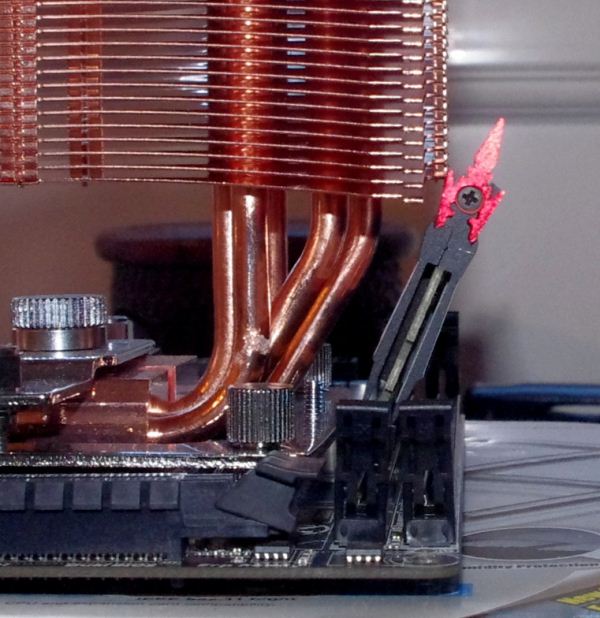
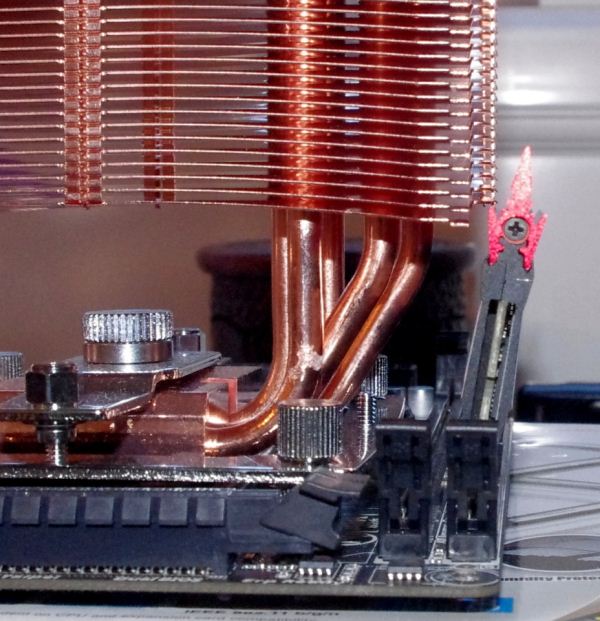














28 Comments
View All Comments
Samus - Sunday, October 28, 2012 - link
ditto, they're ridiculous. older g.skill memory (2008-2011) had a clean, effective design, this is pretty childish.primonatron - Sunday, October 28, 2012 - link
Why keep posting photos of RAM with heat spreaders not fitting on the mini-ITX board in reviews? The board is obviously not designed to accomodate them, and to keep posting the pictures just looks like the reviewer is stupid and hasn't learnt that yet. It even says under the photos the review is on an ASUS P8Z77-V Premium. A proper full size ATX, is what the companies would expect buyers to be using.just4U - Sunday, October 28, 2012 - link
It gives the user an idea (perhaps?) of how it will fit in their own setup if their using a large cooler. It sort of does need to be mentioned (almost as a disclaimer) for any buyers looking at ram when their system is in need of something with heatsinks of a lower profile.JeauxBleaux - Sunday, October 28, 2012 - link
and both have wasted vast amounts of page space and my time showing memory stick profiles that won't fit on a motherboard that was never intended to carry those sticks in the first place. Memory sticks may or may not have a tall profile due to their heatsink(s) but may also have fan kits mounted on them in the absence of huge heatsinks.What is the point of that? The author's choice of motherboard and massive cooling tower obviously preclude the use of most high performance memory w/heatsinks and/or fan kits and would certainly lead me to believe that the author has little experience in thoughtfully putting together a "system" in which all components play well together.
So, while I appreciate the benchmarks the author displays and the consideration that has gone in to the testing of these memory sticks, a more appropriate representation of the ill fit of these particular memory sticks would be a simple one-liner and maybe ONE picture of what NOT to try to mount them in. Because, seriously, it makes the author look like he/she is simply trying to make the maufacturer look and only succeeding in making himself/herself look ignorant.
just4U - Sunday, October 28, 2012 - link
It doesn't matter if it was meant for a low end setup or now.. there are alot of higher end boards that won't allow for that clearance either when paired with certain coolers.bunnyfubbles - Sunday, October 28, 2012 - link
part me wishes that faster memory could actually make a difference in real world performance, the other part is thankful I need no more than the low profile Samsung 30nm green stuff :)GhostClocking3 - Monday, October 29, 2012 - link
If you're willing to spend the money for better RAM you should easily be able to afford to go water to make it fit. That ultimately led me to have to switch since air cooler had to get larger to to cool more effectively.I don't blame anandtech for showing the RAM fitting, that is probably the most frequently asked question ever. Does it fit, blah, blah, blah.
Tchamber - Monday, October 29, 2012 - link
So if so many of these kits have clearance issues, and don't generate a lot of heat, why are the spreaders so tall? So they can charge more? Or do the aesthetics really sell?Guspaz - Monday, October 29, 2012 - link
This review (and the one that preceded it) really just go to illustrate how pointless all this is. Clockspeed, latency, the differences in these don't translate to any significant difference in real-world performance. There's not much point, it would seem, in buying anything beyond something cheap and reliable (KVR if you don't want heatsinks, basic HyperX if you do). Any extra money spent on top of that would have been far better spent on a faster CPU.So, if you've got 16GB of RAM, you can pay $70 for KVR, or $80 for HyperX... Or you can pay $340 for the RAM reviewed here
And you know what? There's no real performance difference in real-world applications. Oh, sure, you see a percentage point or two here and there, but you know what will give you a much bigger boost for your extra $260? Getting a faster CPU or GPU. Those will make a FAR bigger difference than the RAM.
Guspaz - Monday, October 29, 2012 - link
I think the point of my comment above is "Please stop reviewing useless memory kits and review something that actually matters."Reviewing these things is a waste of everybody's time, both yours and ours.